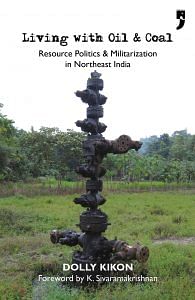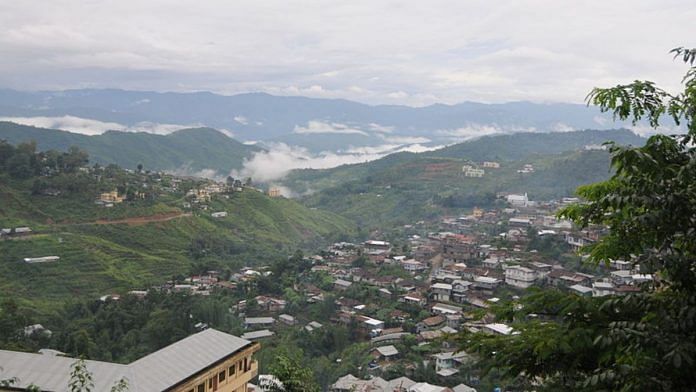The militarized carbon landscape, as I discovered, was a thriving space of symbols, meanings, and people’s accounts and connections with the land. In addition, the ongoing extractive activities engaged links to the past, present, and future: traders invoked the past to assert kinship ties and connections between the hills and the plains, while security forces stationed there monitored the movement of people every day, and geologists and coal miners invoked a desirable carbon future. When I arrived in the foothills, there were multiple ways to understand this place.
In the beginning of the world there were two brothers. The older one was Naga, and the younger one was Assamese. The Naga was naive, while the Assamese was shrewd. One day, their mother tied both boys to a tree and left. She used firm cane ropes to tie the older son but tied the younger one with a tender creeper. The younger brother immediately got free and caught up with his mother. In his joy, he grabbed her feet and rolled on the ground. The areas where the younger brother rolled became the plains.
After a few days, the elder brother managed to break the cane rope, but he failed to track down his mother and brother. Devastated at the loss, he hit the ground with a stick, crying and mourning. The areas where the stick struck became rivers, streams, cliffs, and mountains. A few years later, the older brother—the Naga in the hills—learned that his mother and brother were in the plains and went down to visit them. When he arrived at his younger brother’s house, he saw gold, silver, salt, and abundant granaries. His younger brother was prosperous and well clothed. The opulent life of the plains attracted the elder brother, but he missed his home in the hills and decided to go back.
However, as he climbed the hills, he kept turning around to look at the plains because he was sad to leave his brother and mother. When the elder brother arrived at his home in the hills, he found that his livestock had escaped into the forest and become wild. The goat became a deer, the pig became a wild boar, and the pony became a wild horse. Even the vegetables in his garden became wild. The betel nuts in his garden became bitter nuts, and his vegetables turned into inedible plants. Since then, the inedible vegetables and plants belonged to the elder brother who lived in the hills, while the edible plants and good clothing belonged to the younger brother in the plains.
This origin myth was popular among the coal traders of Assam and in the Naga villages involved in coal mining. The retelling illustrates how local legends, colonial cartography, and administrative divisions produced the foothills as a distinctive site, but it also sheds light on a broken relationship. Attributes such as peace, harmony, and other values of sociality were often added to the myth through recollection. For example, in the Ahom and Naga villages where trading and resource extraction deals were made, this legend was told as a sign of brotherhood and camaraderie, while in locations that had experienced land conflicts, the story was narrated to reconcile the warring groups.
Another popular legend highlighted social and political relations between communities of the hills and the plains. This one centered on food. According to Pakum, the pastor of Yonlok village, many centuries ago an enemy named Maan-Singhpo came to attack the Ahom kingdom during the reign of King Gadadhor. The Ahom king escaped to the hills, and the Phoms offered refuge to the king and helped him defeat the enemy. After the battle, the Ahom king gifted paan (betel leaf) to the Phoms as a token of gratitude. This local legend also recounts that the bhot jolokia (Naga chili) in this part of the world came from enemies, since it was found among the food supplies abandoned on the battlefield. At first, the villagers planted the Naga chilies and wore them as ornaments around their ears until they discovered them to be edible. Today, both paan and Naga chilies are sold at the weekly markets known as haats across the foothills. Pakum concluded, “We have always been together [the hill and valley dwellers]. I say that the Assamese and the Namsang people [Nagas] can never become enemies!” Contextualizing the legend as an integral part of the political economy, Pakum said, “The paan leaf we eat now was a gift from the king. We continue to sustain our economy with the paan. It is the king’s paan.”
Also read: One of the world’s spiciest chillies — Sikkim’s Dalle Khursani — to get GI tag
The Nagas have long been described as hill-dwelling people and non- Nagas as plains people from Assam. Initially, the coal traders seemed to reiterate the dominant hill and valley model. As we know, hill and valley have been important sites of knowledge production across the Himalayan region, including Northeast India. Anthropologist Edmund Leach (1954), in his seminal work on highland culture and social structures in the highlands of Burma, argues that societies are defined and reproduced by the topography and agro-ecology that sustain them. He details how study of cultivation, residence, and trade between the Kachin and their neighbors contributes to an academic understanding of the role of identity, culture, and social structure for the highland Kachin. Leach’s descriptions of hill societies alternately resisting and attempting to emulate valley societies continue to affect the way relatively egalitarian, nonhierarchical societies of the hills (or what Leach calls the “Chinese model of rule of law with regard to succession and mundane daily affairs”) are contrasted with their counterparts in the valley, which show more Indic influences of periodic bloodletting and violence, especially during times of transition.
Contemporary scholarship on the hill/valley continuum in Northeast India has become a rich area of inquiry. Historians, social anthropologists, and political scientists have used variations of Leach’s work to highlight modern problems of governance and representation (Baruah 2005; van Schendel 2005; Scott 2009). James Scott (2009), in particular, has relied on and developed Leach’s work to explain the political and historical dynamics of hill societies in upland Burma. His description of the hills as “non-state spaces” historically constituted by societies that resisted taxation and the centralized control of autocratic kings, complements Leach’s emphasis on the importance of agro-ecology in understanding complex outcomes of modern state-making in places like upland Burma (and by Scott’s own admission, Northeast India).
When studying people from the foothills who spoke multiple languages and created different ethnic alliances and trading networks, it became important to highlight the in-between places. The eco-tonal topography of the foothills produced new relations and practices, a point that Scott confirms as he explains how geographical features like slopes and highlands “constitute yet . . . other ecological, political and cultural zones” (Scott 1998: 187). Although Scott does not focus on the foothills, the experiences of the people I met during my fieldwork illustrate the impact of distinct geographical features.
The origin myth about the brothers is not about reiterating or rejecting a hill-and-valley framework. Instead, it forces us to reexamine accounts of escape, war, and mobility, as well as how people appropriate local legends and the past to establish social and political alliances for resource extraction in a place where the state has been present as a militaristic entity. Many people I met in the foothills were unemployed and did not have land in the hills (Nagaland) or the valley (Assam). Thus, the myth leads us to look at departure not in terms of severing relationships with certain places, but as an opportunity to reiterate a historical fracture that requires mending. Like a scene caught in a loop, residents of Naga coal mining villages and traders from Assam constantly narrated the sorrows of the elder brother’s departure to the hills to reconnect and establish new kinship ties. In the same spirit, the broken bond between the brothers is used to explain misunderstandings and resource conflicts. The foothills emerge as a geographical and natural resource prism that refracts the social relations and resource extractions in the hills of Nagaland and the Brahmaputra Valley of Assam. People connect and imagine their physical surroundings in varied ways, but their attempt to gain access to natural resources produces distinct configurations of power and authority on the ground. Visible encounters take place at the numerous checkpoints located across the foothill border every day.
Also read: Tensions soar between Assam Rifles & Mizoram govt, force faces apology deadline
Everyday life on the foothill border between Assam and Nagaland revolves around travel restrictions and curfews. Since India’s independence in 1947, Northeast India has witnessed a low-intensity war. Considered the center of the longest insurgency movement in South Asia, Northeast India has been home to approximately 158 armed groups that have waged war with India since the 1950s, and a total of 36 insurgent groups are still operational, according to the South Asia Terrorism Portal. In 1958, the Armed Forces Special Powers Act (AFSPA), an extraconstitutional law to aid counterinsurgency operations, was implemented in the region. The AFSPA was founded on legislation introduced by the British administration in 1942, known as the Armed Forces Special Powers Ordinance. The AFSPA suspends the protection of life and personal liberty guaranteed under Article 21 of the Indian Constitution and grants unconditional impunity to the armed forces operating under the AFSPA in disturbed areas. Section 3 of the AFSPA describes the procedures by which the government of India has the power to declare an area “disturbed” and impose the act in the following manner:
- Power to Declare Areas to be Disturbed Areas—If, in relation to any State or Union territory of which the Act extends, the Governor of that State or the Administrator of that Union Territory or the Central Government, in either case, if of the opinion that the whole or any part of such State or Union Territory, as the case may be, is in such a disturbed or dangerous condition that the use of armed forces in aid of the civil powers is necessary, the Governor of that State or the Administrator of that Union territory or the Central Government, as the case may be, may by notification in the Official Gazette, declare the whole or such part of such State or Union territory to be a disturbed area.
Section 4A of the AFSPA empowers the Indian armed forces to open fire on the public to the extent of causing death, to carry out arrests, or to conduct searches on any premise without warrant if the armed forces are of “the opinion that it is necessary to do so for the maintenance of Public order.”

This excerpt of Living with Oil and Coal has been published with special permission from Yoda Press.




Until Nagaland and Assam boys & girls see Indians coming in 1947, they realized there are real demons in this world of fairy tale, who after invaded them, terrorizing them with systematic massacre of men and gang raping their women using AFSPA. When they resisted, invader Indians called them insurgency and terrorists.